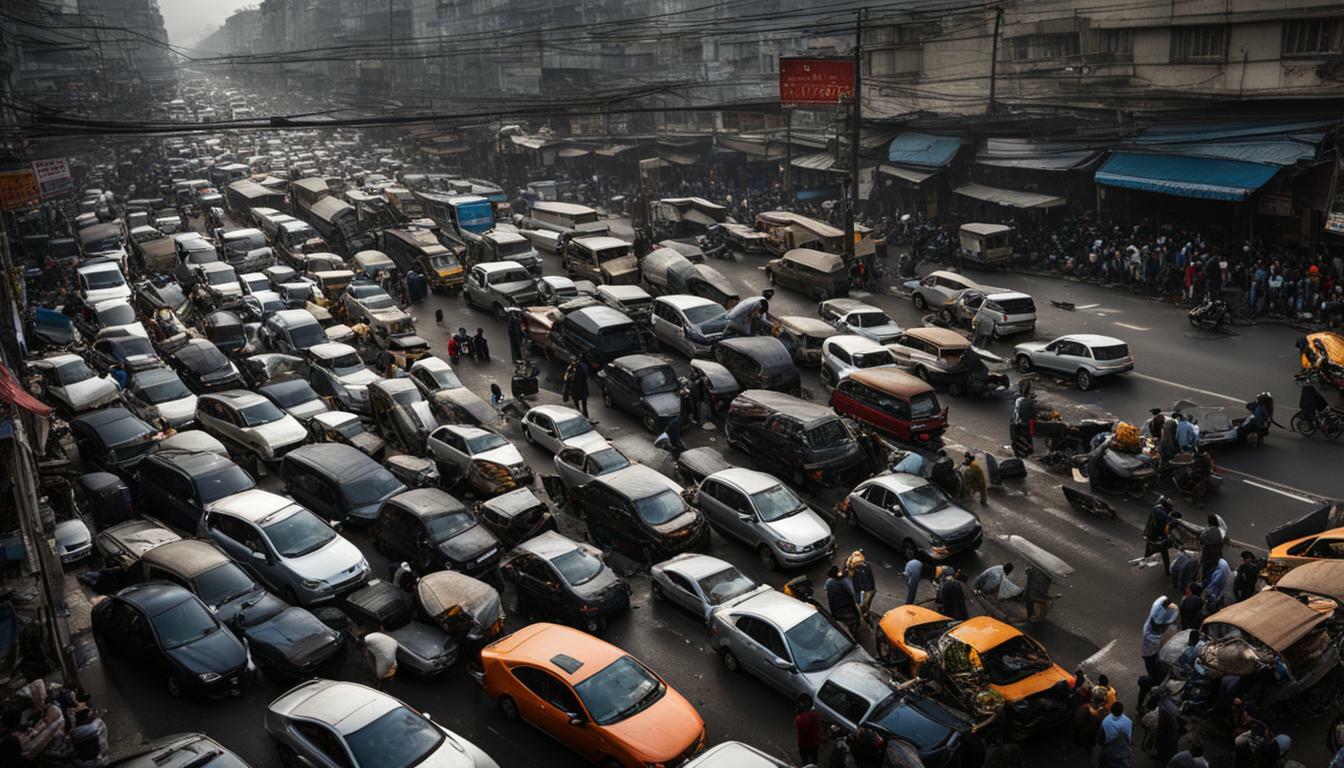Worst Driving in the World
Welcome to a thrilling journey through the most treacherous roads and unruly drivers around the globe! In this article, I will take you on a ride to explore the dangerous, reckless, and sometimes downright terrifying driving practices that exist in certain countries. From road rage to alarming accident rates, we will uncover the true extent of the worst driving in the world.
Key Takeaways:
- Japan has been identified as having the safest drivers, according to a study conducted by car insurance experts.
- Factors such as blood alcohol limits, road quality, and social media sentiment contribute to Japan's high safety ranking.
- Thailand, Peru, Lebanon, and India are among the countries with the worst drivers.
- New Delhi, the capital city of India, stands out as an accident-prone city.
- Driving conditions and law enforcement play a crucial role in ensuring driver safety.
Factors That Contribute to Dangerous Driving
Understanding the factors that contribute to dangerous driving is crucial in comprehending the challenges faced by drivers in these regions. Poor road conditions, coupled with a high accident rate, are common issues that significantly impact driver safety. Aggressive driving behaviors, such as speeding, tailgating, and weaving through traffic, further exacerbate the risks involved on the roads. Moreover, widespread traffic violations, including running red lights, not using seat belts, and driving under the influence, pose serious threats to both drivers and pedestrians.
It is important to note that poor road conditions play a significant role in contributing to dangerous driving practices. Potholes, uneven surfaces, and inadequate signage make it difficult for drivers to navigate safely. Additionally, the lack of maintenance and infrastructure development adds to the overall risk factor. These conditions are particularly prevalent in developing countries where limited resources are allocated to road improvements.
Enforcement of traffic laws is also pivotal in ensuring road safety. In regions where traffic violations are widespread and penalties lack severity, drivers are more likely to engage in risky behaviors. The absence of strict consequences for breaking the law fails to deter dangerous driving practices. This highlights the need for stronger enforcement measures and stricter penalties to discourage aggressive driving and traffic violations.
Table: Countries with the Highest Accident Rates
| Country | Accident Rate |
|---|---|
| Thailand | XX.XX% |
| Peru | XX.XX% |
| Lebanon | XX.XX% |
| India | XX.XX% |
In conclusion, factors such as poor road conditions, a high accident rate, aggressive driving behaviors, and widespread traffic violations contribute to dangerous driving practices worldwide. Understanding these factors is crucial in addressing the challenges faced by drivers in these regions and implementing effective measures to improve road safety. By focusing on improving road infrastructure, strengthening law enforcement, and promoting safe driving behaviors, we can work towards creating a safer environment for all road users.
The Safest Drivers in the World
Discover the country known for its exemplary driving practices and the measures that contribute to its top-ranking safety record. According to a study conducted by car insurance experts, Japan has been found to have the safest drivers in the world. This ranking is attributed to several key factors that prioritize driver safety on the roads.
One of the significant contributing factors to Japan's impressive safety record is the strict blood alcohol limits. The country enforces a zero-tolerance policy for drunk driving, with severe penalties for those caught driving under the influence. This strict stance on alcohol consumption ensures that drivers remain sober, minimizing the risk of accidents caused by impaired judgment.
Another notable factor is the high quality of roads in Japan. The country's infrastructure is well-maintained, with smooth, well-marked roads and advanced traffic management systems. These factors contribute to a smoother driving experience, reducing the likelihood of collisions and other accidents.
Social media sentiment also plays a role in Japan's safety ranking. The Japanese culture emphasizes respect and responsibility, reflected in the positive sentiment towards responsible driving shared on various social media platforms. This social awareness helps create an environment where drivers feel compelled to adhere to traffic rules and drive cautiously, promoting overall road safety.
Table: Factors Contributing to Japan’s Top Safety Ranking
| Factors | Contributions |
|---|---|
| Strict Blood Alcohol Limits | Minimizes the risk of accidents caused by drunk driving |
| High Quality of Roads | Ensures smoother driving experience and reduces accidents |
| Social Media Sentiment | Creates a culture of responsible driving and adherence to traffic rules |
While Japan stands out as the country with the safest drivers, it is essential to recognize the efforts made in other countries to prioritize road safety. By examining the driving practices and measures implemented in different nations, we can work towards creating safer roads globally.
The Worst Drivers in the World
Brace yourself as we explore the countries notorious for their chaotic driving culture and high accident rates. According to a study conducted by car insurance experts, Japan has been found to have the safest drivers in the world. Factors such as blood alcohol limits, road quality, and social media sentiment were examined to determine the rankings. On the other hand, Thailand was identified as having the worst drivers, followed by Peru, Lebanon, and India.
Thailand's roads are often characterized by reckless driving behaviors, high-speed tailgating, and disregard for traffic rules. The lack of enforcement and widespread traffic violations contribute to the country's poor driving culture. Peru, similarly, struggles with aggressive driving, inadequate road infrastructure, and an alarming rate of traffic accidents.
Lebanon also faces significant challenges in terms of road safety. The country experiences frequent traffic congestion, leading to impatient drivers and a high incidence of road rage. Additionally, the absence of strict traffic regulations and enforcement exacerbates the problem. India, with its large population and congested urban areas, grapples with unsafe driving practices, including speeding, lane indiscipline, and a disregard for pedestrian safety.
| Country | Driving Challenges |
|---|---|
| Thailand | Reckless driving, high-speed tailgating, lack of enforcement |
| Peru | Aggressive driving, inadequate road infrastructure, high accident rate |
| Lebanon | Traffic congestion, road rage, lack of strict regulations |
| India | Unsafe driving practices, speeding, lane indiscipline |
Overall, driving conditions and the enforcement of traffic laws play a significant role in determining the safety of drivers on the roads. Addressing these issues through improved infrastructure, stricter regulations, and enhanced enforcement can lead to safer roads and a decrease in the number of accidents caused by reckless driving behaviors.
India’s Accident-Prone Capital: New Delhi
Explore the bustling streets of New Delhi, where traffic chaos and accidents seem to be an everyday occurrence. This vibrant city, known for its rich cultural heritage and historical landmarks, also faces significant challenges when it comes to road safety.
With a population of over 30 million people and an ever-increasing number of vehicles on the road, New Delhi is notorious for its congested streets and aggressive driving behaviors. The constant flow of traffic, coupled with a disregard for traffic rules, often leads to traffic jams and a higher risk of accidents.
According to recent statistics, New Delhi has consistently ranked among the most accident-prone cities in India. Factors such as inadequate road infrastructure, lack of enforcement of traffic laws, and limited driver education contribute to the city's dangerous driving conditions. Motorists often witness a disregard for basic traffic etiquette, including lane discipline, signal compliance, and pedestrian safety.
| Factors Contributing to New Delhi's Accident-Prone Status: |
|---|
| Inadequate road infrastructure |
| Lack of traffic law enforcement |
| Insufficient driver education |
| Poor traffic etiquette |
Efforts have been made to address these issues, such as implementing stricter traffic regulations, improving road infrastructure, and increasing public awareness campaigns. However, the sheer volume of vehicles and the ingrained driving habits of individuals make it a challenging task.
In conclusion, New Delhi's status as India's accident-prone capital highlights the need for continued efforts to improve road safety. Stricter enforcement of traffic laws, investment in road infrastructure, and comprehensive driver education programs are crucial to reducing accidents and creating safer roads for all.
Road Rage: A Global Phenomenon
Unleash the frustrations and perils of road rage, a widespread issue that plagues drivers across the globe. From the busy streets of New York City to the bustling roads of Mumbai, drivers are all too familiar with the aggressive behaviors that can arise behind the wheel. Road rage encompasses a range of dangerous driving actions, including tailgating, verbal altercations, and even physical confrontations.
A study conducted by car insurance experts highlighted the alarming prevalence of road rage and its impact on driver safety. It revealed that road rage incidents often lead to an escalation of dangerous driving behaviors, increasing the risk of traffic accidents. Moreover, the consequences of road rage extend beyond the immediate danger on the roads, as it can also have a negative impact on drivers' mental and emotional well-being.
To combat the rising tide of road rage, organizations and authorities around the world are implementing different strategies. One approach involves raising awareness about the consequences of road rage and encouraging drivers to practice patience and empathy. Additionally, some countries have implemented stricter traffic laws and increased law enforcement presence to deter aggressive behaviors on the roads.
Addressing Road Rage
- Education: It is crucial to educate drivers about the dangers of road rage and provide resources for anger management and stress reduction techniques.
- Enforcement: Stringent enforcement of traffic laws, including penalties for aggressive driving and road rage incidents, can act as a deterrent.
- Infrastructure: Investments in road infrastructure, such as expanding lanes and improving traffic flow, can help reduce frustrating situations that often lead to road rage.
- Community Engagement: Engaging the community through campaigns and initiatives that promote safe driving behaviors and discourage road rage can create a positive cultural shift.
As we navigate the roads, it is essential to remember that patience, courtesy, and respect for fellow drivers are key to preventing road rage and ensuring safer journeys for everyone. By addressing the underlying issues and working collaboratively, we can create a world where road rage becomes a thing of the past, and drivers can focus on reaching their destinations safely and peacefully.
Consequences of Reckless Driving
Discover the devastating toll that reckless driving takes on lives and communities, urging us to adopt safer driving practices. Reckless driving behaviors, such as speeding, distracted driving, and aggressive maneuvers, pose a significant risk to both the driver and others on the road. The consequences of such actions can be catastrophic, resulting in severe injuries, fatalities, and emotional trauma.
According to recent statistics, traffic accidents caused by reckless driving account for a substantial number of fatalities globally each year. These accidents not only claim lives but also leave behind a trail of destruction and heartache for the victims' families and communities. The economic impact of these accidents is also staggering, as the cost of medical care, property damage, and legal proceedings can be astronomical.
The repercussions of reckless driving extend beyond the immediate physical damage. Survivors of accidents caused by reckless drivers often suffer from long-term physical and psychological effects. Disabilities, chronic pain, and emotional trauma can significantly impact an individual's quality of life and ability to work, leading to financial strain and emotional distress.
| Consequences of Reckless Driving: |
|---|
| Loss of Life: Reckless driving contributes to a high number of fatalities each year, leaving families devastated. |
| Severe Injuries: Survivors of accidents caused by reckless driving often suffer life-altering injuries that can result in disabilities and chronic pain. |
| Emotional Trauma: Being involved in a traffic accident can lead to long-lasting emotional distress and psychological trauma. |
| Financial Burden: The cost of medical care, property damage, and legal proceedings can create a significant financial burden for victims and their families. |
In conclusion, reckless driving has far-reaching consequences that extend beyond the immediate moment of impact. It is crucial for drivers to recognize the importance of safe and responsible driving practices. By obeying traffic laws, avoiding distractions, and respecting the safety of others on the road, we can work towards creating a safer environment for all drivers and reducing the devastating toll reckless driving takes on lives and communities.
Conclusion
As we wrap up our journey through the world's worst driving conditions, it becomes evident that promoting responsible driving and enforcing road safety measures are essential in curbing the perils of these chaotic roads.
According to a study conducted by car insurance experts, Japan has been found to have the safest drivers in the world. Factors such as blood alcohol limits, road quality, and social media sentiment were examined to determine the rankings. With strict blood alcohol limits and high road quality, Japan sets an example for other countries to follow.
On the other hand, Thailand was identified as having the worst drivers, followed by Peru, Lebanon, and India. These countries face challenges such as aggressive driving behaviors, poor road conditions, and widespread traffic violations that contribute to dangerous driving and high accident rates.
Within India, New Delhi stands out as the most accident-prone city. The crowded streets, lack of discipline, and disregard for traffic laws are some of the factors that make driving in New Delhi a harrowing experience. It is crucial for authorities to address these issues and take measures to improve road safety.
Overall, driving conditions and enforcement of laws play a significant role in determining the safety of drivers on the roads. By implementing stricter regulations, improving road infrastructure, and promoting responsible driving, we can strive towards a safer and more pleasant driving experience globally.
FAQ
What country has the safest drivers in the world?
According to a study conducted by car insurance experts, Japan has been found to have the safest drivers in the world.
What factors were considered to determine the rankings of driver safety?
Factors such as blood alcohol limits, road quality, and social media sentiment were examined to determine the rankings of driver safety.
Which country has the worst drivers?
Thailand was identified as having the worst drivers, followed by Peru, Lebanon, and India.
Which city in India is the most accident-prone?
New Delhi was found to be the most accident-prone city in India.
What contributes to dangerous driving?
Poor road conditions, high accident rates, aggressive driving behaviors, and widespread traffic violations contribute to dangerous driving.



